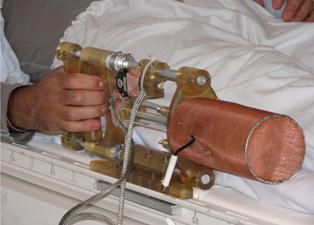fMRI shows robotic hand exerciser improves brain function of stroke patients
10 December 2008
Chronic stroke patients can be rehabilitated by a hand-operated robotic device, according to a study that used functional MRI (fMRI) scans to map changes in the brain. The study, presented at the annual meeting of the Radiological Society of North America (RSNA), is the first to use fMRI to map the brain in order to track stroke rehabilitation.

A volunteer squeezing the handles of the Magnetic
Resonance
Compatible Hand-Induced Robotic Device (MR_CHIROD) while
lying in the magnet of the MRI scanner.
"We have shown that the brain has the ability to regain function through rehabilitative exercises following a stroke," said Dr Aria Tzika, director of the NMR Surgical Laboratory at Massachusetts General Hospital (MGH) and Shriners Burn Institute and assistant professor in the Department of Surgery at Harvard Medical School in Boston. "We have learned that the brain is malleable, even six months or more after a stroke, which is a longer period of time than previously thought."
According to the Centers for Disease Control and Prevention, stroke is the third leading cause of death in the US and a principal cause of severe long-term disability. Approximately 700,000 strokes occur annually in the US, and 80% to 90% of stroke survivors have motor weakness.
Previously, it was believed that there was only a short window of three to six months following a stroke when rehabilitation could make an improvement. "Our research is important because 65 percent of people who have a stroke affecting hand use are still unable to incorporate the affected hand into their daily activities after six months," Dr Tzika said.
Dr. Tzika is an affiliated member of the Athinoula A. Martinos Center for Biomedical Imaging in the Department of Radiology at MGH, where the research is ongoing.
To determine if stroke rehabilitation after six months was possible, the researchers studied five right-hand dominant patients who had strokes at least six months prior that affected the left side of the brain and, consequently, use of the right hand.
For the study, the patients squeezed a special MR-compatible robotic device for an hour a day, three days per week for four weeks. fMRI exams were performed before, during, upon completion of training and after a non-training period to assess permanence of rehabilitation. fMRI measures the tiny changes in blood oxygenation level that occur when a part of the brain is active.
The results showed that rehabilitation using hand training significantly increased activation in the cortex, which is the area in the brain that corresponds with hand use. Furthermore, the increased cortical activation persisted in the stroke patients who had exercised during the training period but then stopped for several months.
"These findings should give hope to people who have had strokes, their families and the rehabilitative specialists who treat them," Dr. Tzika said.
Bookmark this page